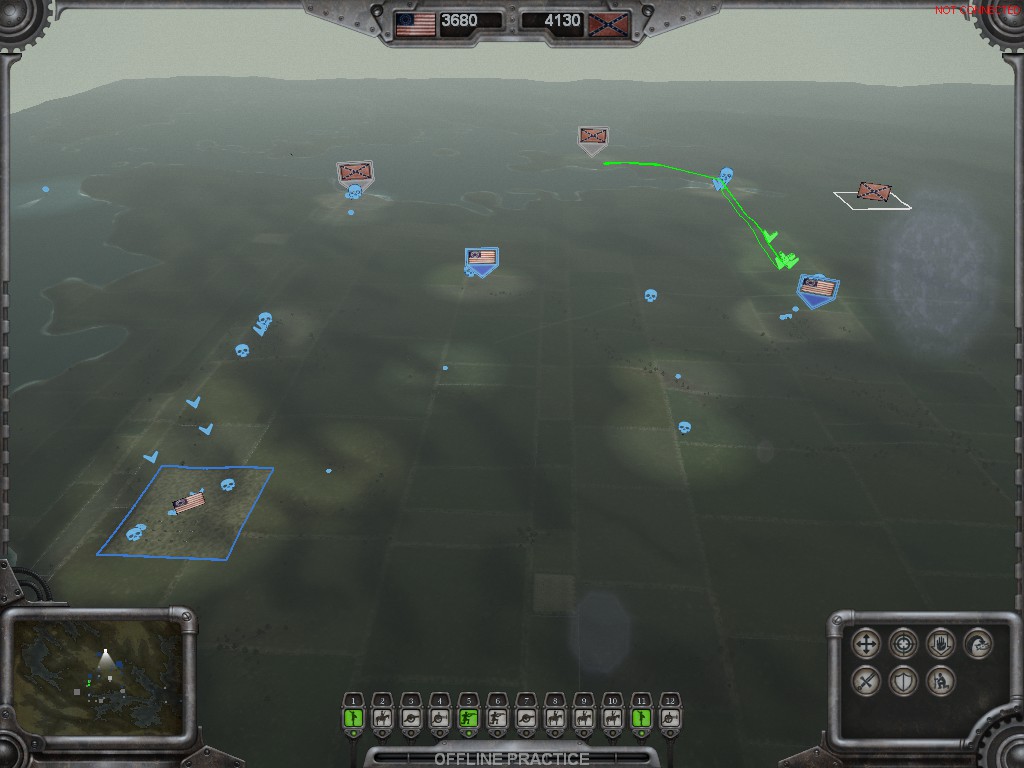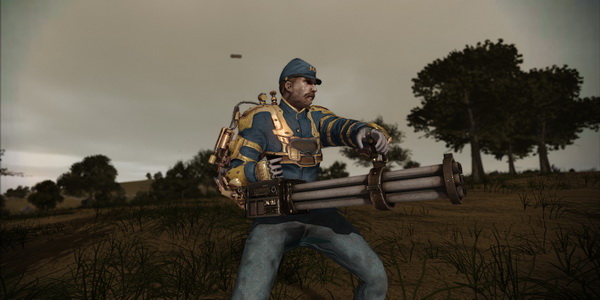Remember all the time you spent daydreaming on the idea of going back in time to give the Confederates better technology to fight the Union during the American Civil War? Me neither, but that is the off-kilter premise of developer Radioactive Software’s off-kilter RTS-TPS hybrid, Gettysburg: Armored Warfare.
Mixing the ability to take direct control of a single soldier or vehicle in a real-time strategy game is nothing new to the world of gaming, and Gettysburg: Armored Warfare has not set any genre defining bars. As a matter of fact, both Toy Soldiers: Cold War and Iron Brigade (Trenched) on the Xbox Live Arcade’s marketplace have had real-time strategy elements mixed with third-person shooting mechanics and they’re both far superior games than Gettysburg: Armored Warfare.
There are numerous reasons why other games are superior, but ultimately Gettysburg: Armored Warfare is a game stripped down to its barebones in nearly every aspect. The main menu only consists of an offline skirmish, online multiplayer, and game options. There is no story mode to speak of and not much of anything else to give an incentive to continue playing. The only reason I know that the premise is supposedly about technology coming back from the future to aid one side or the other in the American Civil War is simply because I watched a developer video on the game and that developer talked about those storied aspects, you would never gather any of this from just playing the game itself. Every game feature in Gettysburg: Armored Warfare seems like the bare minimum to be considered a game.

From the RTS perspective of Gettysburg, the game is not very engaging and there is truly not much to be found in any type of a strategy department. There are only two game modes – skirmish and death match. Neither mode have much strategy to them. When starting in both skirmish or death match you choose your side between Confederacy or Union, land on one of four extremely similar maps, and then you select your army. When selecting your army you pick between different types of soldiers and vehicles which range from things like 1860’s infantry, cavalry, cannons, blimps, boats, and then you have the future assets like the 2060’s Gatling gun infantry, rocket troops, snipers, tanks, anti-aircraft ballista, and so on. You pick your army which is comprised of twelve slots made-up of these different soldiers and vehicles and they spawn at your home base.
There are also NPC friendlies that spawn apart from your selected army. You cannot interact with them in anyway by either taking control of them via third-person or by the RTS map overview to give them orders around the battlefield; they just go do whatever they want. So, basically the objective to win is very simple, you grab your twelve assets and the game is based solely around a capture-and-hold-the-flag motif. You move your assets to a ‘?’ on the map and hold that zone until a meter runs long enough to turn that location into your allegiance’s flag. Both sides have a number at the top of the screen which starts at 10,000 and indicates each side’s resources. When you hold a position the resource number will decrease more slowly for you depending on the number of locations you hold for your faction. Also, each troop or vehicle has a resource value attached to it. So, when you gun down (or get gunned down) a troop or vehicle that asset will have to respawn at a home base and it will subtract the unit's value from the resources each time to respawn a new asset. First side down to zero loses.
There really is nothing more to the game than that. Sure, you can double click on any one of these troops or vehicles to take direct third-person control of it and each soldier and vehicle tries to bring different aspects to battle, but ultimately the third-person controls are shoddy and the retical-to-hit ratio is nothing to speak highly of either.

The third-person perspective is really where the game starts to show its weak craftsmanship as well. When you get down on the ground-level the game doesn’t look pleasing from an aesthetic point of view. Trees and textures pop in and out of existence sporadically, troop animations are clunky and clip through objects, and then the polar opposite might happen when you’re in a tank and you’ll hit invisible walls or houses that are twenty or thirty feet away from your vehicle. The game was meant to be played from far away, looking down and not up-close and personal.
The game was developed with a large, ambitious multiplayer feature in mind. The online multiplayer is set with a maximum capacity of up to 64 players on a single map at one given time. When you get even upwards of 3-5 people in a single match it can enhance the game quite a bit, but the game has basically no player-base and it’s hard enough to find two people to play with simultaneously, let alone anything even resembling sixty people at the time of this writing.
Gettysburg: Armored Warfare is not a good game. It was built with a huge multiplayer foundation in mind but there is no community to back it, so any ambitious multiplayer aspirations become moot. Regardless, that hardly matters because the real-time strategy elements barely qualify for strategy. The lack of varied gameplay mechanics should make any fan of the genre look elsewhere for their strategy needs, the same goes for the third-person shooter features. The Battle of Gettysburg was in Pennsylvania and it is renowned for having more deaths in the American Civil War than that of any other battle, those are just facts. Let’s chalk this up as another causality to Gettysburg and be done with it.